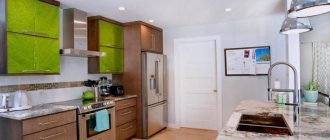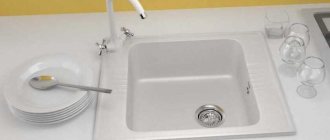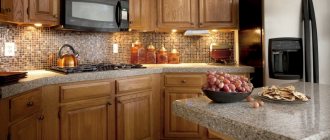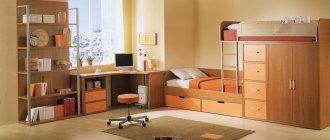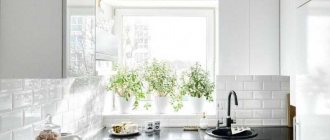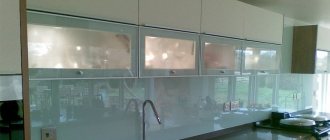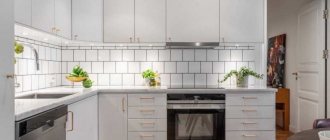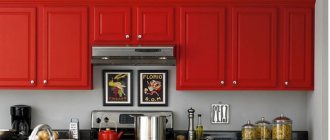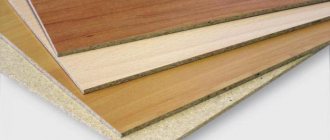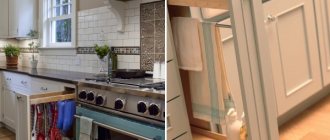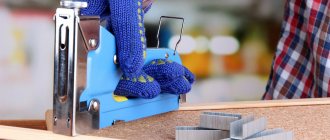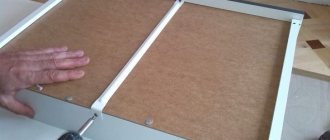Before buying a kitchen set, each of us first of all pays attention to its external facade, because we want the kitchen we choose to fit harmoniously into the interior of the room; you can make a table for the kitchen to go with the kitchen set. However, not everyone focuses on such an important aspect as the material from which it is made.
In our article, we will share with you in detail comprehensive information about what material is better to buy a kitchen from, which material is more practical as a frame, which one is suitable for the facade, and we will also tell you about the advantages and disadvantages of each material. And also find out which ceiling is better to choose for the kitchen.
Frame materials
laminated chipboard
Let us remind you that the basis of chipboard is dried wood shavings and formaldehyde resin (6-18%). Despite the fact that the production of chipboard is quite complicated (the process includes three stages: kneading, molding, pressing and drying), the price of the material is low.
Laminated chipboard is obtained through the lamination process - a film is applied to a sheet of chipboard.
Laminated chipboard may well serve as a frame for cabinets, but on the condition that dishes that are not too heavy are stored there. The thickness of the slabs varies from 16 to 24 mm.
Advice! If you nevertheless decide to buy a kitchen made of laminated chipboard, then place the top drawers at a distance of at least 70 cm from the countertop and away from the stove. This will help minimize the impact of steam on the headset and thereby extend its service life.
MDF
MDF, like laminated chipboard, is composite. Its basis is finely chopped shavings and lignin, almost to dust. During the production of MDF, hot pressing occurs, which creates a high-strength material that is twice as hard as, for example, chipboard. Due to the fact that MDF-based frames are eco-friendly and moisture-resistant, they are optimally suited for kitchen furniture. If the surface of the slab is finished with natural veneer, then the kitchen frame will be similar to a solid wood kitchen.
Solid wood
From time immemorial, wood has been very popular for the manufacture of kitchen furniture, thanks to its qualities - it not only looks aesthetically pleasing indoors, but is also safe for health.
However, when choosing a kitchen, it is important to remember that not every breed is suitable for use in places of high humidity. It must be dry and treated with a special composition against fungi and water. This, in turn, significantly increases the cost of the material.
Kitchen fronts and cabinets
If you do not yet clearly distinguish between these two concepts, then pay attention to the terminology. Kitchen body and facade - what is it? Let's note the fundamental differences:
- The body of the kitchen set is the basis, the frame of the kitchen furniture. It is a base module to which shelves, drawers, frames and fronts are attached.
- The facades of kitchen furniture are its external external elements, in particular doors and decorative panels.
Next we'll talk about cases. If you want to learn more about facades and the materials used to make them, we recommend a feature article on our blog.
Facade materials
Chipboard and fibreboard
As a facade, these materials can be used in budget options. They are often used to make kitchen doors.
Flaws:
- They are afraid of high humidity, which can cause them to swell.
- Due to the deformation of the material, the fittings also fail.
MDF
Despite the fact that MDF is a fairly expensive material (30% more expensive than chipboard), it is much more practical and durable.
The advantages of MDF include the following:
- It has high moisture resistance.
- When exposed to hot steam, it does not swell or warp.
- MDF is completely safe, as it contains only environmentally friendly materials.
- It is very easy to process (paint, laminate, etc.).
- Products made from MDF can be given almost any shape (convex, voluminous, etc.).
- Easy to care for.
- It does not dry out or become deformed - you can safely install it near the stove.
But even this material has its drawbacks:
- It loses its brightness when exposed to sunlight.
- It is easy to scratch.
- If the surface of the facade is damaged, it will not be possible to partially paint it.
Advice! A kitchen made of MDF looks quite simple, so to diversify the facade and add life to it, you can combine the kitchen from different colors, adding curved lines on the drawers themselves or on the side cabinets.
Solid wood facades
Let's look at the most common types of wood that are used for kitchen furniture:
Larch. This type of wood is ideal for making kitchens. The advantages include:
- High density and strength.
- Moisture resistant.
- Almost no knots.
- Withstands high mechanical loads.
- Practically not subject to rotting.
- Beautiful and pleasing to the eye reddish-brownish color.
Birch. Although birch wood has high strength, it is quite easy to process. Its downside is that it is susceptible to rotting.
Oak. It was loved by everyone because of its qualities - strength, resistance to rotting and flexibility. In addition, oak is so beautiful in itself that a kitchen made from it is a real work of art.
Pine. This breed is also the most commonly used in kitchen production. The disadvantage of this tree is the knots and resin shells, which complicate its processing.
Spruce. It is of higher quality, as it does not warp and has sufficient moisture resistance. The disadvantage of spruce is that it is difficult to decorate.
Kitchen facade: which material is better
Facade – doors and drawer linings of furniture sets, which determine the style of the interior. It is made from various materials that differ in appearance, durability and price.
Solid wood
It is this material that is recommended to be chosen for creating kitchen sets in a classic style. It is environmentally friendly, natural, beautiful, but at the same time quite expensive. As experience shows, facades are often combined: wood is used for the frame, and veneered MDF is used as the central insert (panel). This option is not only cheaper than 100% solid wood, but also more practical (it avoids door deformation).
The durability of a solid wood facade directly depends on the quality of the raw materials. The wood must be thoroughly dried. Hardwoods such as oak, ash and beech are best suited for facades. Solid pine kitchens also have the right to exist, but please note that this material is too soft and unstable to mechanical damage.
- The advantages of solid wood are naturalness, environmental friendliness, and restoration is possible in case of damage.
- The disadvantages of the array are difficulties in care. So, the kitchen must always have normal humidity (40-60%) so that the set does not dry out or become deformed. It is not recommended to expose a solid wood façade to heat or direct sunlight.
LDSP (laminated chipboard)
The most accessible material.
- The advantages of laminated chipboard are low price and wide possibilities in terms of decoration.
- A disadvantage of laminated chipboard is its instability to steam and moisture. However, with high-quality laminated chipboard kitchen elements covered with edging tape, furniture made from this material can last a very long time.
MDF
The most popular material, characterized by a good ratio of price and practicality. It can be painted, covered with a polymer film, lined with plastic or natural veneer. To a greater extent, it is the finishing that determines the advantages and disadvantages of MDF, so we will look further into the question of which material is better for the kitchen.
Veneer
We are talking about a thin section of wood (thickness up to 3 mm), glued to MDF or chipboard. Matte or glossy varnish is used as a finishing coat.
- The advantages of veneer are similarity to solid wood in appearance and feel, long service life, and the ability to be restored in case of minor damage.
- Disadvantages of veneer - it is not resistant to steam and moisture, it requires varnishing, as it can change its color.
PVC film
One of the most affordable decorative materials. Pasting with MDF film is carried out under the influence of a vacuum press. If this stage is performed efficiently and competently from a technological point of view, then the film will retain its color even after several years and will not peel off.
- Advantages of PVC film - suitable for curved facades and available in a variety of textures and colors.
- Disadvantages of PVC film - it cannot be restored if damaged. If errors were made during production and installation, bubbles will appear on the surface of the film, and it will quickly lose color or come off completely.
Plastic
Covering the front part of the facade with a layer of HPL plastic is a popular solution. Unlike film, this material is denser and stronger. Kitchens made of plastic are more glossy, which makes them very stylish.
- The advantages of plastic are a variety of colors and textures, reasonable price, durability. This material does not deform under the influence of hot steam.
- Disadvantages of plastic - fingerprints remain.
When choosing kitchens made from plastic to order, please note that only smooth and solid facades can be made using this material.
Acrylic
Another option for headsets with glossy surfaces. It was the mirror shine that made this material incredibly popular.
- The advantages of acrylic are non-toxic, wear-resistant, and available in a rich palette of colors.
- The disadvantages of acrylic are its high price and instability to stains.
Choose custom acrylic kitchens if you are ready to take care of such a kitchen. In the line of modern household chemicals there are many excellent products that cope with any contamination. Therefore, if you like a spectacular shine, choose acrylic facades.
Multiplex
Since a kitchen made of wood is not a cheap pleasure, a more affordable analogue has appeared on the market - multiplex material. At the same time, kitchens made of this material look no worse than wooden ones, and at the same time have excellent performance properties.
What are they made from?
Multiplex is thin layers of wood of different species glued together. It can rightfully be called universal, since it is actively used not only for kitchen sets, but also for armrests, various cabinet elements and sofas.
Advantages:
- High moisture resistance.
- Environmentally safe and does not emit harmful substances.
- Capable of taking on almost any shape.
Plastic
It is important to note that in plastic kitchens, the plastic itself does not act as the material from which the kitchen set is made, but as the material for its finishing.
Plastic facades are produced in two ways:
- Plastic is glued to MDF (has a longer service life).
- The plastic is glued to the chipboard.
Both of these methods provide high-quality and reliable material, but those with MDF will be more expensive in price.
Let's consider the advantages of plastic kitchens:
- Extensive color palette.
- Such facades are environmentally friendly.
- The kitchen looks expensive and attractive.
- Resistant to high temperature, moisture and odor.
- Not susceptible to fading in sunlight.
- Quite a long service life.
Kitchen fittings
A noticeable and important component of the appearance of any kitchen is the fittings. Even the most modest kitchen set can be transformed by choosing beautiful handles and convenient mechanisms for opening/closing cabinets. To ensure that the fittings last for many years, choose products from trusted manufacturers such as Blum and Firmax.
- Handles for the kitchen. These can be staples (textured, curved, smooth, etc.), rails (square, round or rectangular), buttons (plastic, metal, wood, etc.) and mortise handles.
- Furniture legs. Typically, they are made of stainless metal and can be round, square or rectangular.
- Rails (used for attaching hooks and small nets with “pockets”). They are durable and resistant to high humidity. Rails can be suspended, horizontal or vertical.
- Hinges for cabinets and doors (hidden, overhead, gas lift, transformable hinges). They provide ease of use of the lockers.
- Guides for retractable systems (roller or ball). Such fittings are responsible for the comfort and ease of use of individual storage systems.
Properly selected fittings prevent premature breakdown and damage to the furniture set, so focus on the style, quality and practicality of such elements.
Kitchens made of MDF film or plastic
PVC coatings are often used in finishing MDF facades due to their durability, resistance to fading and low price. Thanks to the availability of films of various colors and textures, you can create different kitchens.
The disadvantage of PVC is that, compared to plastic, it is less resistant to negative influences - due to sudden changes in temperature or humidity, the film can peel off.
What types of kitchen cabinets are there?
Depending on their type (floor-standing, hanging or pencil cases), they have different load-bearing capacities. Massive modules are usually made of a material of increased thickness that is more resistant to external influences. In the case of hanging cabinets, the area where they are attached to the wall is of particular importance, since the load in these areas increases greatly.
We will be happy to recommend you the best solutions for the manufacture of cabinets for kitchen units. In our work, we use only high-quality materials that ensure durability, reliability and wear resistance of each piece of furniture!
Kitchens made of MDF with enamel
In itself, such a coating looks very interesting, since it can be not just matte or glossy, but have various effects (chameleon, metallic, pearl shine, etc.).
Enamel is applied to the treated furniture surface in several layers, which makes the coating more durable.
Pros:
- Rich palette of colors and effects.
- Easy to clean (do not use only abrasives).
- It is possible to create bent and other, more complex forms of facades.
Minuses:
- The price is higher than that of PVC coatings.
- Less resistant to ultraviolet radiation.
Kitchen countertops: which one is better?
The material for the countertop can be postforming (30 mm or 40 mm chipboard, processed using special technology), acrylic, solid wood, artificial and natural stone, marble, ceramic tiles, etc. There are at least 10 options in total. At the same time, more and more new solutions often appear. To choose the appropriate option, consider the requirements for the countertop:
- resistance to moisture, mechanical damage, steam and aggressive substances;
- hygiene and ease of care;
- durability and color fastness;
- aesthetic properties.
So, kitchen countertop: which material is better? Based on your chosen style. For example, wooden countertops ideally complement classic kitchens or will become a contrasting element in modern sets. They are presented in a variety of colors and textures. A stone countertop is perfect for a minimalist style set. It will become a bright accent in any interior. Evaluate the merits of a particular material and listen to expert advice on choosing a countertop.
- The simpler the design of the entire kitchen, the more concise the countertop should be.
- Natural stone countertops are not suitable for small kitchens.
- Products made from natural and artificial stone are very hard, so you need to place cups and plates on them carefully.
- From a practicality point of view, a matte surface is better than a glossy one.
- It is better to make countertops made of MDF and chipboard light. Over time, this material fades, which is very noticeable on dark products.
The service life of a good countertop is at least 6 years. During this time, the product should not lose its appearance.
Plastic or MDF - which facades are better to choose?
In fact, it all depends on what goal you are pursuing. Plastic is more expensive, but is the most durable and has good performance. PVC film coating is considered the most affordable option. But with the help of enamel you can achieve interesting effects.
Acrylic facade
The basis for applying acrylic is usually MDF or chipboard panels, the thickness of which is about 2 cm. The acrylic coating layer is no more than 3 mm. To ensure tight, long-lasting adhesion, a special press-adhesive technique is used, which eliminates the appearance of delamination and cracks.
The facades can be covered on one side or both, but the cost of the kitchen with the latter option will be more expensive.
Advantages:
- Users note that gloss creates a feeling of versatility of space and makes the kitchen visually more spacious.
- The innovative acrylic facade easily withstands even heavy loads.
- Resistant to moisture, high temperature and scratches.
- Due to the fact that facades made of reinforced acrylic have no pores, the formation of bacteria and fungus is eliminated.
- Non-flammable and non-toxic.
- The acrylic coating is resistant to aggressive household chemicals and even alcohol and vinegar.
Based on user reviews, the disadvantages of acrylic facades include:
- The need to coat the acrylic surface every six months with a special product that prolongs the glossy appearance of the panel.
- Any, even minimal fingerprints are visible on the glossy surface.
Aluminum
A façade based on this material is considered a novelty on the market. As a rule, it consists of the metal frame itself, filler (wood, glass, plastic, MDF, etc.) and fittings.
An aluminum facade filled with glass makes the set much lighter, and if you make sliding doors, this will help save space.
Fake diamond
It is considered the most durable material. Withstands heavy loads, is not afraid of chemicals and moisture. Bacteria do not multiply on it; you can choose any color shade that will not fade over the years. However, when using it, the frame of the headset must be strong enough. In addition, a facade made of artificial stone is an expensive pleasure.
Which interior to choose for the kitchen?
Before this, we mainly considered the functionality of the kitchen, but its appearance is also very important - according to tradition, the kitchen is considered the center of any home, the place where the whole family gathers every day.
The kitchen is often combined with the dining room or replaces it; guests are received here and various celebrations are celebrated.
- Classic style. Classic requires high ceilings, space, air and light. In a dark and small kitchen, this style will create a depressing mood. Classics are brass or bronze fittings, natural wood, natural tones and straight lines, paneled facades.
- Art Nouveau is a fairly popular style; it is flexible and diverse. A distinctive feature of modernism is the severity of lines, simplicity and limited palette - most often these are two restrained and contrasting shades. This interior can be endlessly complemented with various expressive elements, adhering to the basic design line or playing with contrasts.
- High-tech is distinguished by austerity, simplicity and minimalism, it is filled with dreams of a cosmic future - these kitchens look like the cockpit of spaceships from science fiction films.
- To organize high-tech kitchens, appropriate materials are used - glass, steel, glossy plastic. Most often, the colors are restrained - gray, white, black, pale blue. This style is quite effective, but it also has its drawbacks - it requires order and does not combine with excess kitchen elements.
- Country style. Comfort, warmth, charming rural simplicity, vintage and handmade items, a little creative chaos - these are its distinctive features.
For a “country house” effect, choose wooden, light-colored furniture – painted white, with a natural pattern. Brass, wooden or ceramic fittings, wicker baskets, bright fabric tablecloths, antique ceramics and bundles of dried herbs will complement the interior.
What color to choose for the kitchen? Both designers and psychologists agree that color significantly affects mood and even health. It has been proven that green and blue colors make us eat less, while orange and red colors improve appetite.
Soft green shades - mint and pistachio - are soothing and have a positive effect on digestion. Cold dark gray, dull black and brown are the most inappropriate colors for the kitchen, which subconsciously depress.
Tabletop materials
The countertop is the most used part of the kitchen unit. It is this element that is constantly exposed to chemical stress more often than other elements. What material is better to order? Let's consider the options.
The most widely used are the following:
Fake diamond
It is divided into:
- Acrylic - durable and aesthetic. The main component is acrylic resin.
- Polyester is cheaper than the first option, but is not inferior in strength. It is made from polyester resin.
- Quartz is not afraid of acids. The basis is rocks and various decorative admixtures.
A natural stone
Divided by:
- Granite is durable, smooth, without pores, the surface is resistant to high temperatures. Of the minuses: a large presence of moisture leads to its destruction.
- Marble is durable, safe, has a unique design, looks expensive and rich. Minus: it is afraid of chemicals and easily absorbs liquid, which means it is not very practical.
Tree
Although a wooden tabletop looks quite attractive and can be given any shape, it is quite finicky and requires constant care.
- Every six months to a year it must be varnished (oiled) and restored as needed.
- This countertop is resistant to sharp objects and hot dishes, so it requires delicate handling.
Ceramic tile
Thanks to the wide range, you can realize any design ideas. Today the market offers a sufficient number of budget options that will help decorate your kitchen. A tile countertop does not require any special care, except that the grout needs to be renewed from time to time.
MDF
As a temporary option, a countertop based on this material is quite suitable. MDF lamination will even provide moisture resistance and protection from damage. There is a choice of color and pattern. Among the disadvantages, it can be noted that it is not resistant to temperature changes and due to the accumulation of too much water, cracks may appear at the joints between the plates.
Plastic
Many plastic countertops are based on chipboard panels with a thin but durable coating of special HPL plastic. There are also models with MDF.
These materials are combined using the postforming method, which involves the use of high temperature and pressure. In this case, not only the horizontal surface, but also the leading edge is covered with plastic. The result is a smooth and even surface, without joints or seams.
The basis of HPL plastic is compressed multilayer kraft paper impregnated with special resins.
Thanks to the presence of a layer of polymer material on top, the product becomes durable, resistant to moisture, light, chips and mechanical damage.
Plastic is often used to imitate wood, marble or granite. Many people choose this type of countertop because of its aesthetic and functional qualities.
The advantages include:
- Affordable price.
- Rich color palette.
- Using a wide arsenal of household chemicals (with the exception of those that can ruin the outer laminated layer - acetone, acids).
- In terms of its aesthetic qualities, plastic is not inferior even to natural wood or stone.
- Such a countertop can withstand elevated temperatures, but it is better to place a pan that has just been removed from the heat on a stand.
Which kitchen façade is more practical: advice from experts
So, let's make a checklist that will facilitate the process of choosing material for the kitchen.
- Facades are the face of a kitchen unit. They are the ones who set the mood and form the overall style. For those who love the classics, the best material is considered to be solid wood or a combined solid wood (wooden frame and veneer). Connoisseurs of modern solutions will like acrylic and plastic. When you need a budget kitchen, choose chipboard.
- The frame is the basis of the kitchen, which is practically invisible. This is a hidden element of the headset that carries a serious load. From the point of view of strength and practicality, laminated chipboard is suitable, but if the client wishes, individual (visible) elements of the body can be made of solid wood.
- The tabletop is both a work area and a bright accent. It is made from a wide variety of materials: from chipboard to granite. Which to choose? Budget, overall kitchen style and personal preferences are three factors that will help you answer this question correctly.
- Fittings are elements that provide ease of use of furniture. A cheap and ugly handle can ruin even the most fashionable set. You can't skimp on accessories. Silent closing of cabinets, ease of access to shelves and a presentable appearance - you will definitely appreciate these and other advantages if you choose good fittings.
Glossy or matte surface
Whether the surface will be glossy or matte depends on what type of HPL plastic is used.
- Matte - slightly rough, its structure resembles an orange peel. Suitable for kitchens with a classic design.
- Glossy - perfectly smooth and shiny. Looks good in modern minimalist kitchens.
If you are in doubt about which kitchen surface to choose, today the market offers smooth glossy panels with a slight shine; these are the ones you can give preference to.
As for the thickness of plastic countertops, most of them come in two sizes: 28 and 38 cm. The second option is several times more expensive than the first, but its performance leaves much to be desired.
Experts advise paying attention to countertops based on lightweight chipboard with a thickness of 60 mm. Also choose HPL rather than CPL coating. The first option is better suited for the kitchen, as it is more durable, resistant to fading and damage.
The appearance and service life of the countertop in most cases depends on the type of plastic used to cover the chipboard: 0.4-0.5 - domestic or Polish; 0.8 - German.
Complete kitchen set
Which kitchen is better to choose? This will depend on the needs. Do you like to cook and host holiday dinners for your friends? Choose a kitchen set with a large number of cabinets and work surfaces.
If you only plan to brew coffee in the morning and invite friends to relax in the evening, then you don’t need an abundance of tables, but you may need a bar counter or a table for serving dishes.
Each kitchen is divided into 3 main zones : storage area, washing area and cooking area. In order for the kitchen to be comfortable, it must be planned according to the principle of a triangle, which connects these zones. It is best that the total distance between zones is no more than 5 meters.
It’s great if all the working parts form one line, but when the size of the kitchen does not allow it to be done this way, then the break must be made where one of the operations ends. , an L-shaped or linear layout is best ; in large rooms, you can make a U-shaped kitchen with many work surfaces.
Small kitchens have more stringent planning requirements. For better comfort, choose cabinets with sliding doors and try to rationally use all the space. For example, in the gap between the refrigerator and the work table, you can install a narrow pull-out cabinet for bottles. In a large kitchen, you can choose a set with hinged and pull-out cabinets.
Kitchen decoration from apron to ceiling
A kitchen apron is part of the wall behind the work surfaces and performs not only a protective, but also an aesthetic function. It is decorated with finishing materials that are resistant to moisture, temperature and other adverse factors:
- tile;
- stone;
- panels made of wood, bamboo, MDF;
- glass panels were removed;
- mosaic and decorative panels;
- metal
The ceiling is also designed to match the kitchen environment. The presence of a wide range of models and installation options allows you to create ceilings of various types in the kitchen. In this case, almost any materials are used:
- wallpaper, plaster, whitewash or paint
- figured plasterboard structures
- PVC panels
- stone or tile
- wooden decorative beams
- suspended rack systems
- stretch ceilings of different textures and colors
- combined ceilings
Kitchen layouts
To create the kitchen of your dreams on your own, you need not only to study which material is best for the kitchen, but also to take into account some important points when planning the space.
- It’s logical to fill a narrow space with wall cabinets or open shelves
- Make the most of your desk height
- retractable or folding table will save space
- a wide window sill will serve as an additional work surface
Kitchen components
Furniture in the form of floor and hanging cabinets is the main point in filling the kitchen space. In turn, it consists of individual elements, both visible and hidden. If you look at what modern kitchens are made of, you can identify the following main components: frame, facades, countertops.
Frame - what matters is what's at the core
The frame or body is the backbone of the kitchen, on which all its visible beauty rests. It includes: bottoms, walls, covers of internal modules. To make the base, inexpensive but fairly durable materials such as chipboard and MDF are used, less often wood. More often, the choice is based on the principle of which material is cheaper for the kitchen. Caracas can be prefabricated or glued. In the first case, ease of transportation is ensured, in the second - a more durable factory connection of parts.
Facades are the “face” of the kitchen
Facade - furniture elements - usually doors - that are located in the visible vertical part of the kitchen unit. The material for the production of kitchens and facades is listed above, and they can be made in any style and combination.
- Made from solid wood of various species - luxurious and classically stylish.
- MDF coated with veneer looks no less noble than wood.
- MDF coated with film - affordable and popular.
- MDF coated with enamel - does not fade in the sun.
- MDF coated with plastic - bright and inexpensive.
- MDF coated with acrylic - environmentally friendly and moisture resistant.
- Chipboard - economical and modest.
- Laminated chipboard is an improved material, it looks decent.
- Glass facades made of transparent, frosted, colored or corrugated glass are elegant and festive.
- Metal facades are stylish and modern.
- Frame and paneled facades: based on an MDF frame. They suggest a combination of materials and textures.
Knowing what kitchen sets are made of, you can choose furniture to suit your taste and budget.
Countertops made of various materials
Along with the facades, the countertop is an inseparable element of kitchen sets: the cooking process is unthinkable without it, it decorates the room and unites individual elements. Therefore, the choice of material for a kitchen set also implies the choice of a worktop material, for the production of which the following are used:
- wood – mostly pine or oak
- natural stone
- artificial stone
- moisture-resistant laminated chipboard
- Coated MDF
- tempered or triplex glass
- stainless steel metal sheets
- combined materials
Reliable kitchen furniture manufacturers offer the best materials for kitchen furniture, which are guaranteed to last the allotted time.
If you decide how to choose an inexpensive kitchen, then you need to start from the materials that make it up.
Window sill as part of a set
To maximize the use of kitchen space, the window sill often becomes part of the kitchen environment. Having decided for yourself what material to choose from for the kitchen, you can make a window sill in the same style. It will look equally good made of wood, coated MDF, natural and artificial stone, tiled or mosaic.
